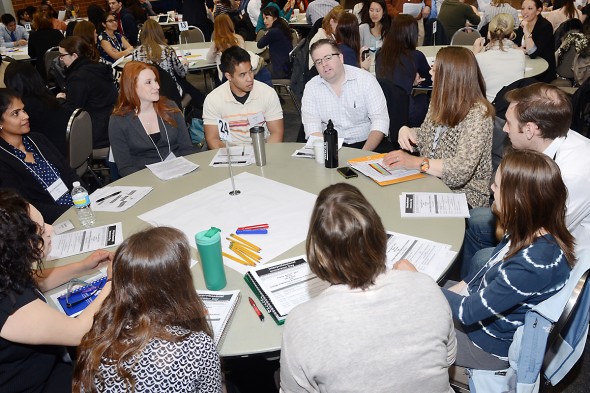Health sciences students learn to work together

UIC health sciences students talk through medical scenarios during Interprofessional Immersion Day April 5 at the UIC Forum. Photo: Mark Mershon
For each patient, there are many pieces to the puzzle.
After being admitted to the hospital, patients interact with nurses, doctors and pharmacists. Meanwhile, their records are in the hands of staff members who work in health informatics. And specialists may be consulted.
With so many people involved in the health care delivery system, communication is key, said Mary Keehn, clinical associate professor of occupational therapy.
It’s crucial to educate the next generation of health care workers about the importance of collaboration, she said.
“One of the biggest problems related to patient safety is the amount of errors made in medical care, and a lot of that comes down to communication,” said Keehn, associate dean for clinical affairs in the College of Applied Health Sciences.
“Research shows that when health care professionals work together more successfully, it improves patient outcomes and reduces costs.”
More than 800 UIC students — and 150 via satellite from the College of Medicine’s Rockford campus — gathered at the UIC Forum April 5 for Interprofessional Immersion Day.
Health sciences students were assigned tables and collaborated with their peers to discuss three fictional patient scenarios. Students from 11 health sciences programs were divided so that a variety of disciplines were present at each table — from physical therapy and medicine to nursing and nutrition.
A faculty member joined each table as a group facilitator, guiding students to share their perspectives on each scenario, simulated onstage by the Graham Clinical Performance Center.
The event was sponsored by the Collaborative for Excellence in Interprofessional Education, which includes faculty members from the health sciences colleges, library science and the Office of Diversity.
The group presented a pilot seminar to about 30 students last spring and expanded it this year to include more students and greater collaboration, Keehn said.
Talking through the scenarios provided a variety of perspectives, said Christopher Bell, a graduate student in health informatics.
“There’s usually not a lot of interprofessional communication — there are barriers as to why this doesn’t happen now and we worked through the barriers to find the best way to make this kind of collaboration happen in a real setting,” said Bell, project coordinator in the University Health Service.
Bell’s group decided that regularly scheduled meetings among members of a patient’s health care team would improve communication. Using his expertise, Bell also suggested that health care workers review each other’s reports and charts through digitized medical records.
“In the scenario, the patient didn’t feel heard and if the clinicians utilized electronic medical records, it will reduce frustration levels for patients,” he said.
Katie Garwood, a graduate student in occupational therapy, discovered that some health sciences students don’t really understand what occupational therapists do.
“One of our roles is to advocate for our role in the health care team and how we contribute to a health care team,” she said. “We need to communicate with doctors and nurses to show them what part of the puzzle we can help solve.”
Garwood took the opportunity to teach her peers about her profession.
“What we bring to the table is a bigger, holistic view of a person,” she said. “We look at what motivates a person to do something and find ways to help people return to their best life possible.”
Garwood’s group talked about improving collaboration through more efficient electronic communication. But trying to patch the holes in patient care is a large undertaking, she said.
“We just barely touched the surface,” she said. “It’s a really big challenge set before you.
“I appreciate that we had this day to think about how we can be agents of change who want to stand up and say, ‘We want to make health care better and we have to do it as a team.’”
